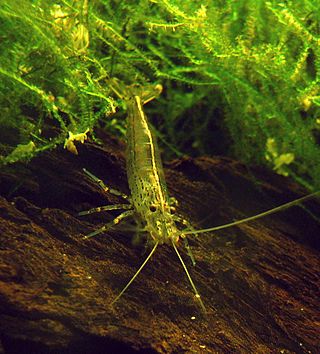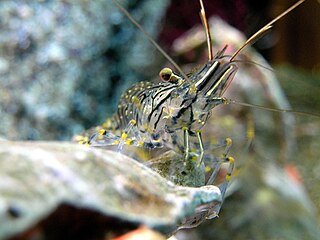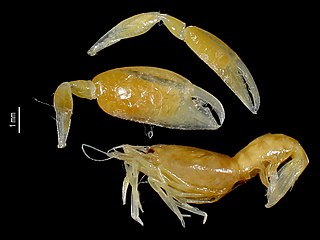
The Caridea, commonly known as caridean shrimp or true shrimp, from the Greek word καρίς, καρίδος, are an infraorder of shrimp within the order Decapoda. This infraorder contains all species of true shrimp. They are found widely around the world in both fresh and salt water. Many other animals with similar names – such as the mud shrimp of Axiidea and the boxer shrimp of Stenopodidea – are not true shrimp, but many have evolved features similar to true shrimp.

Hippolytidae is a family of cleaner shrimp, also known as broken-back shrimp or anemone shrimp. The term "broken-back shrimp" also applies to the genus Hippolyte in particular and "cleaner shrimp" is sometimes applied exclusively to Lysmata amboinensis.

Atyidae is a family of shrimp, present in all tropical and most temperate waters of the world. Adults of this family are almost always confined to fresh water. This is the only family in the superfamily Atyoidea.

Palaemonidae is a family of shrimp in the order Decapoda. Many species are carnivores that eat small invertebrates, and can be found in any aquatic habitat except the deep sea. One significant genus is Macrobrachium, which contains commercially fished species. Others inhabit coral reefs, where they associate with certain invertebrates, such as sponges, cnidarians, mollusks, and echinoderms, as cleaner shrimps, parasites, or commensals. They generally feed on detritus, though some are carnivores and hunt tiny animals.

Ancylomenes magnificus, also known as the magnificent anemone shrimp, is a species of cleaner shrimp common to the Western Pacific Ocean at depths of 3–29 metres (10–95 ft). They are commonly found on stony coral, Catalaphyllia and the sea anemone, Dofleinia armata.

Palaemonoidea is a large superfamily of shrimp, containing nearly 1,000 species. The position of the family Typhlocarididae is unclear, although the monophyly of a group containing the remaining seven families is well supported.

Lysmata is a genus of shrimp in the infraorder Caridea, the caridean shrimp. The genus belongs to the family Lysmatidae. Lysmata are popular ornamental shrimp in the marine aquarium trade for their bright color patterns, interesting behaviors, and ability to control certain aquarium pests such as sea anemones of the genus Aiptasia. They are known to command high prices on the pet market.

Cuapetes is a genus of shrimp in the family Palaemonidae, first described by Austin Hobart Clark in 1919. WoRMS accepts the following species:

Ancylomenes pedersoni, sometimes known as Pederson's shrimp and Pederson's cleaner shrimp, is a species of cleaner shrimp. It is part of the genus Ancylomenes and was described in 1958 by Fenner A. Chace Jr. as Periclimenes pedersoni. Ancylomenes pedersoni is found in the Caribbean Sea, often associated with a sea anemone, at depths of 1 to 15 metres. They are often found on the reefs off Bermuda.

Ancylomenes is a genus of shrimp, erected in 2010 to accommodate the group of species around "Periclimenes aesopius". Members of the genus are widely distributed in the warm oceans of the world, and live in association with cnidarians; most are cleaner shrimp.

Palaemonella is a genus of shrimp in the family Palaemonidae, containing the following species:

Ancylomenes holthuisi is a species of marine shrimp in the family Palaemonidae. It was first described in 1969 by A.J. Bruce as Periclimenes holthuisi.

Periclimenaeus is a genus of decapod crustaceans of the family Palaemonidae which is part of the infraorder Caridea. The genus was named by the English carcinologist Lancelot Alexander Borradaile in 1915. He set out the distinguishing features of the genus as:
Body rather stout, cephalothorax deep, a good deal compressed, abdomen greatly curved Thorax without dorsal swelling. Rostrum rather short, compressed, toothed above only. Outer antennular flagellum not deeply cleft. Antennal scale of good breadth. Mandible without palp. Second maxilliped without podopalp. Third maxilliped narrow, with vestigial arthrobranch.
Urocaridella cyrtorhyncha is a species of shrimp in the family Palaemonidae. The species is similar to U. urocaridella, U. antonbruunii, and U. pulchella. The species is found in the Indian and Pacific Oceans, including the Red Sea.

Zenopontonia is a genus of shrimp within the family Palaemonidae.
Periclimenes exederens is a species of saltwater shrimp in the family, Palaemonidae, and was first described in 1969 by Alexander James Bruce.
Periclimenes madreporae is a species of saltwater shrimp in the family, Palaemonidae, and was first described in 1969 by Alexander James Bruce.

Dactylonia is a genus of shrimp in the family Palaemonidae, first described by Charles Fransen in 2002.
Dactylonia holthuisi is a small shrimp in the family Palaemonidae, first described by Charles Fransen in 2002. The species epithet honours Lipke Holthuis.























